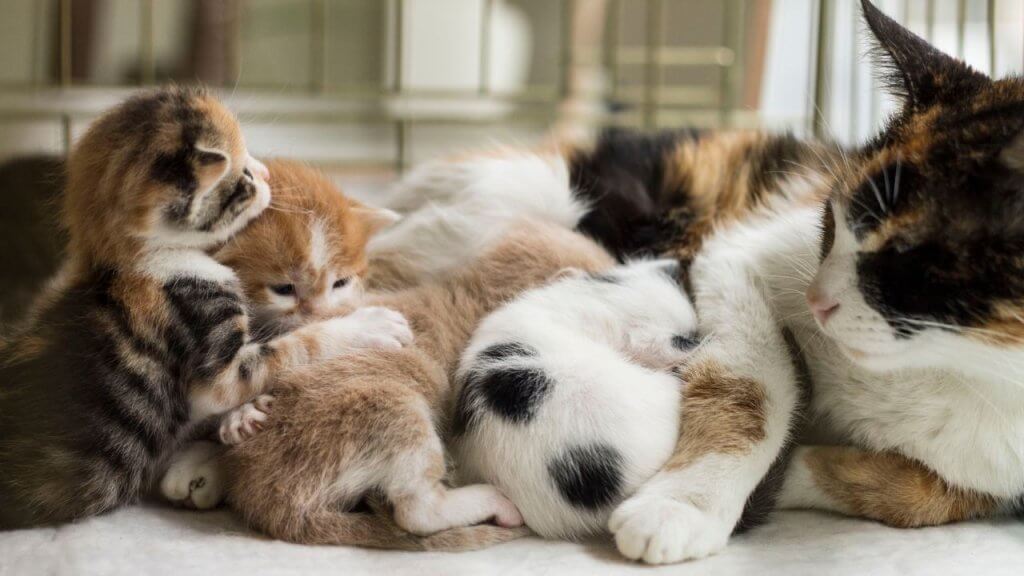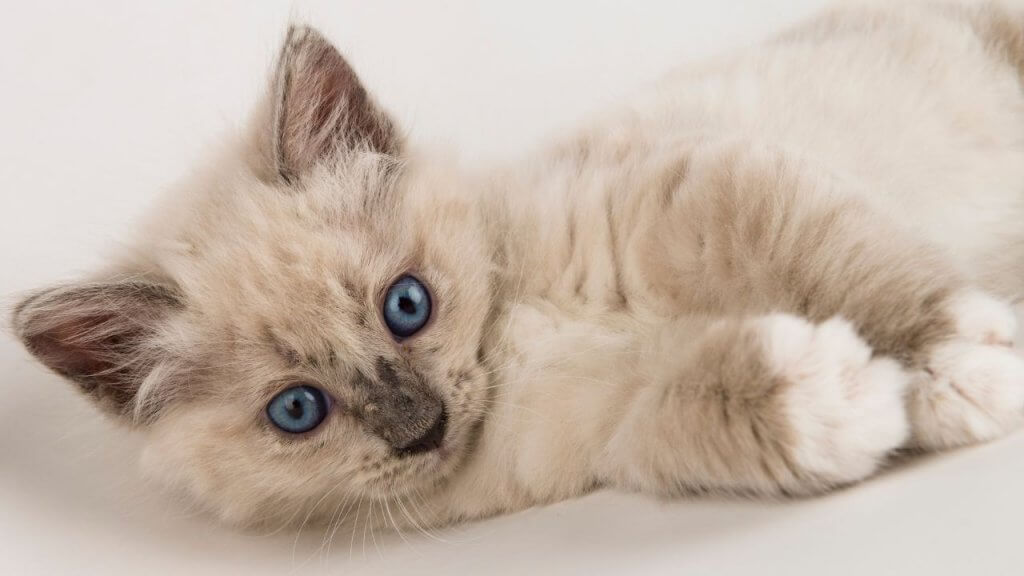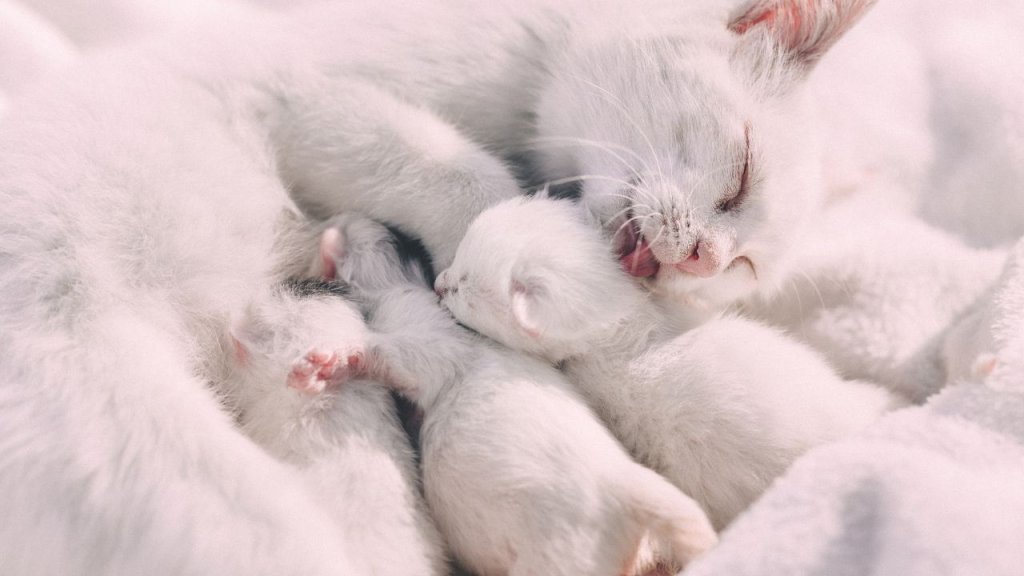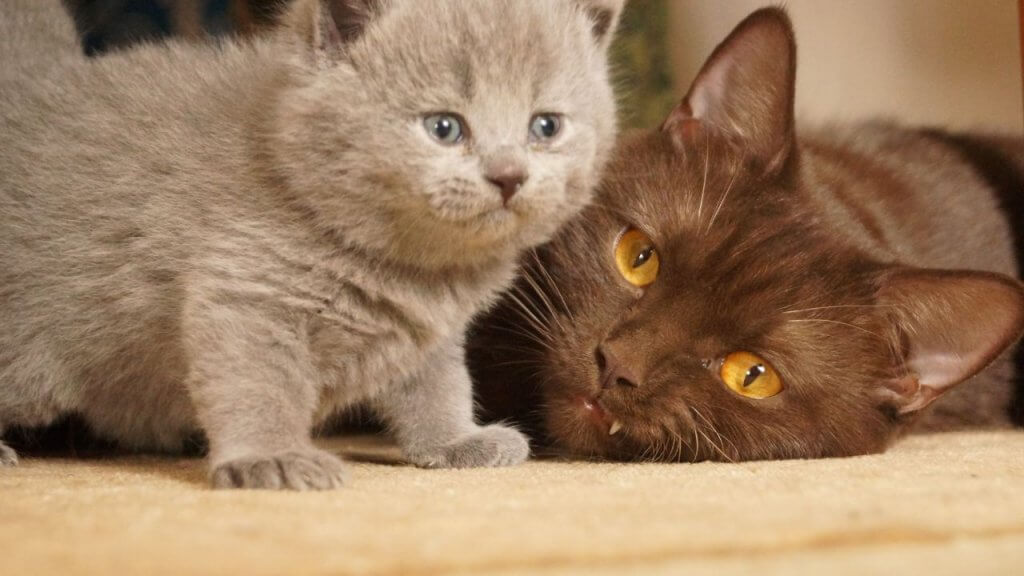It starts with a shift in her purr, a stretch that turns into a nest-digging shuffle. Your once-playful kitty is quieter now, and you can’t help but wonder: “Is she really going to be a mom?” And then the bigger question follows. How many kittens in a first litter should you expect? Either a planned or a surprise pregnancy, you’re now in the tender role of caretaker to a mother-to-be. Let’s find out what to expect from your cat’s first litter so you feel confident and connected through every paw-printing moment.
What Determines How Many Kittens a Cat Will Have?
You might wonder how many kittens a cat has for the first time — whether it will be just one tiny bundle… or a whole parade of paws. The truth is, several biological factors quietly influence how many babies your cat will have.
Age and Maturity 🧬
Young, first-time mothers typically have smaller litters. A queen (female cat) may only deliver one to three kittens in her first pregnancy. Litter sizes tend to increase as she matures and her body becomes more accustomed to gestation. It’s like her body is learning the rhythm of motherhood.
Health and Nutrition 🩺
A well-nourished, healthy cat is likelier to have a larger, thriving litter. Malnutrition, underlying illness, or stress during pregnancy can affect kittens’ development. Sometimes, this leads to fewer births or lower survival rates. Hence, routine vet visits and a pregnancy-safe diet are essential.
Breed and Genetics 🐈
Certain breeds are predisposed to larger litters. For example, Siamese and Oriental breeds often have more kittens, while Persians and other flat-faced breeds may have fewer. Similarly, her mother’s litter history can be an early clue to her own.
First-Time vs. Experienced Mothers 🐾
It’s common for a first-time cat mom to have a smaller litter than her future pregnancies. The uterus is still adapting, and hormone levels are experiencing this process for the first time. But don’t worry — whether she delivers one kitten or five, what matters most is their health and care.
First litters are often nature’s way of easing your cat into motherhood — gently, gradually, and with just the right amount of tiny mews.
The Average Kitten Litter Size (And What’s “Normal”)
For kittens, “normal” comes in many cuddly forms. Most healthy, domestic cats, when asked how many babies do cats have, have litters that fall within a typical range.

📊 National Averages
On average, when thinking about how many kittens in a litter, most cats give birth to three to five. This number is slightly lower in first-time moms, often starting around two to three kittens. This number may naturally rise as your cat’s body adjusts over future pregnancies.
Breed-Specific Differences 🐱
Breed matters more than many people realize:
- Siamese, Bengals, and Abyssinians are known for having larger litters, sometimes six or more kittens.
- With their smaller size or more complex genetics, the Persians, Scottish Folds, and Munchkins may average closer to two or three kittens.
If your cat is a mixed breed, expect a range, and remember, it’s not unusual to be surprised (even after a vet visit!).
When a Small Litter Is Still Perfectly Healthy 🌱
Don’t panic if your cat only has one or two kittens. While it might seem unusual, small litters are very common in first-time moms and don’t necessarily indicate any issues. In fact, fewer kittens can sometimes mean more focused nourishment and less physical strain for the mother.
🩺 Vet Quote:
“Most cats give birth to four to six kittens per litter, but this can vary depending on the cat’s age, breed, and health. First-time mothers often have smaller litters. If you’re unsure what to expect, your vet can perform an ultrasound or palpation to estimate the number of kittens.”
— Dr. Mykhailo Ozmenchuk, DVM
What to Expect from the First Litter
Welcoming your cat’s first litter brings all kinds of anticipation, especially wondering how many kittens in a first litter she might have. For many first-time moms, the size of the litter is one of the first surprises.
🐾 What’s Typical for a Cat’s First Litter?
For most cats, the first litter — often referred to as a cat’s first litter — is smaller than future ones. It’s not unusual for a queen to deliver just one to three kittens her first time. This doesn’t mean anything is wrong — quite the opposite. Her body is simply easing into motherhood, and this gentle introduction allows her to focus on nurturing her newborns without being overwhelmed.

What Might Cause a Small or Large First Litter? 🐣
Several factors can affect litter size:
- Age: Younger cats (under 1 year) may have smaller litters.
- Breed: Some breeds are predisposed to larger or smaller litters.
- Health & nutrition: A well-fed, stress-free mom is more likely to carry more kittens to term.
- Timing of breeding: If the cat is only bred once during her cycle, fewer eggs may be fertilized.
And sometimes, nature just chooses a quiet start.
Reassurance for First-Time Cat Parents 💛
Whether your cat has one kitten or five, know this: every litter is unique — and perfectly hers. The key is watching her closely, ensuring she’s comfortable, and getting her veterinary care when needed. A small first litter isn’t a problem; it’s simply a stepping stone in her journey as a mother.
One kitten or many, it’s still a milestone worth celebrating — full of soft mews, tiny paws, and a heartwarming bond that starts here.
How to Tell How Many Kittens Your Cat Will Have
The wait can feel like forever, especially when you are wondering how to tell how many kittens a cat will have as she starts showing signs of pregnancy. Many pet parents try to guess the number of kittens based on belly size or mood. But while there’s no guaranteed way to count them at home, there are a few accurate methods to help you prepare.
Vet Checkups and Palpation 🩺
Around day 20–30 of pregnancy, an experienced vet may be able to gently feel (palpate) your cat’s abdomen and detect small kitten-sized lumps. This can offer a rough count, though it’s not always accurate, especially if the kittens are close together.

Ultrasound and X-rays 🖥️
For more precision:
- Ultrasound: Can confirm pregnancy and detect heartbeats around day 21, but it isn’t ideal for exact numbers.
- X-ray: Usually done after day 45 of pregnancy, when kitten bones are visible. This is the most accurate way to count kittens before birth.
Ask your vet what they recommend based on your cat’s stage and health.
Myth-Busting: Can You Tell by Nipples or Belly Size? ❌
Many pet parents believe a larger belly or more pronounced nipples mean more kittens. But in reality, these signs don’t correlate with exact litter size. Cats can “look small” and still surprise you with a handful of babies or appear round and deliver just one or two.
While your cat’s body gives hints, only a vet can give you a reliable peek inside. And even then… expect a little magic and mystery.
Preparing for Kitten Birth: A Gentle Checklist
As your cat’s due date approaches, her behavior will likely shift. She may grow more affectionate or more distant. She may hide under beds or curl up in quiet corners. These subtle cues mean it’s time to turn your space into a safe, cozy haven for the new family.
Create a Nesting Area 🧺
Set up a quiet, dimly lit corner where your cat feels safe. Line a box or enclosed space with soft, clean blankets or towels. Ensure it’s in a low-traffic area of your home, away from noise and stress. Some cats will choose their spot. If she does, follow her lead and make it as comfortable as possible.
Provide Warmth and Privacy 🌡️
Kittens can’t regulate their body temperature at birth, so warmth is essential. Keep the room cozy (around 85°F for the first week) and ensure there’s no draft near her nest. Try to limit visitors or curious children and give your cat the solitude she instinctively craves.
Watch for Signs of Labor 🔔
You may notice:
- Restlessness or nesting behavior
- A drop in body temperature (below 100°F)
- Vocalizing or seeking your attention
- Licking her genital area frequently
Labor can begin soon after these signs. If something feels “off,” it’s always okay to call your vet.
Kitten Birth Kit: Supplies to Keep Nearby 📦
- Soft towels or washcloths
- A heating pad (under part of the nesting box, not the whole thing)
- A digital thermometer
- Emergency vet contact info
- A scale for tracking kitten weight (optional but helpful)
- Hand sanitizer and gloves for you (in case you need to assist)
For those planning, the following steps, you can learn how to ethically rehome kittens or prepare for future litters with our kittens for sale guide.
When her world goes quiet and her body begins to work, you’ll know: she’s doing exactly what nature designed, and you’ve given her the space to do it with care.
After Birth: Caring for Mom and Her Litter
Once the kittens are born, a new phase begins. This step is the one that’s just as delicate and full of heart. Your cat will be tired, protective, and focused. Your role now? Gentle guardian and quiet observer.

Right After Birth: What Mom Needs 🍼
Most cats instinctively know what to do. They’ll clean the kittens, nurse them, and keep them close. In the first few hours:
- Replace any soiled bedding with fresh, dry material.
- Offer your cat water and high-quality food rich in calories.
- Let her rest uninterrupted, but stay close enough to monitor.
She may not leave the nest for hours or even a whole day. That’s okay. Just keep everything she needs within paw’s reach.
What’s Normal — and What’s Not 🐾
Normal behaviors:
- Low growling if someone comes too close
- Brief panting or trembling (from exertion)
- Kittens nursing almost immediately
Concerning signs (contact your vet):
- Bleeding that continues for more than a few hours
- A kitten not nursing or being ignored
- Lethargy or labored breathing in mom or any kitten
It’s always better to call your vet early than wait. Even experienced moms can need help sometimes — and so can their humans.
In the following days, you’ll witness something magical: a deep, instinctive rhythm of life that unfolds quietly in your home.
Breeder Verification and Rehoming Responsibly
As those tiny paws begin to grow and eyes start to open, many cat parents start thinking about what comes next. Whether you plan to keep the kittens or find them new homes, doing so ethically and responsibly is part of honoring your cat’s journey. If you are interested in how to become a cat breeder, read our guide.
Why Breeder Verification Matters 🛡️
If you’re a first-time breeder — even unintentionally — the responsibility to vet potential homes can feel overwhelming. That’s why verified breeding practices and trusted directories are so important. Health records, socialization, and living conditions all impact a kitten’s lifelong well-being.
Our breeder verification tool is designed to guide you with compassion and credibility, offering support in everything from documentation to safe buyer connections.
The Right Time to Rehome 🐾
Kittens should stay with their mother for at least 8 to 12 weeks, and ideally closer to 12. Early separation can affect their emotional development, immune system, and social skills. Even if they seem independent at 6 weeks, the presence of mom and littermates still shapes their behavior in essential ways.
Finding Forever Homes, Not Just Buyers 💞

Rehoming is about matchmaking. Take time to:
- Ask questions about the home environment
- Offer tips to new owners on food, care, and early vet visits
- Consider signed adoption agreements for transparency
Our guide on where to sell kittens walks you through it all with kindness at the core.
It can be your only litter or the beginning of a more structured path; whatever it is, thoughtful rehoming gives each kitten a head start built on trust.
From Expecting to Embracing Motherhood
You asked how many kittens my cat would have the first time, and you discovered something more profound: that motherhood, feline or human, should count, and it’s about connection. As those early days unfold and the bond between mother and kittens deepens, let this be the start of a journey filled with heart, learning, and trust.
✨ At American Paws Club, we’re here for every step with breeder verification tools, rehoming guidance, and thoughtful care resources to help you raise and place kittens with confidence and compassion.
Because every paw-printing moment deserves a foundation of love — and a partner you can trust.
FAQs
Is It Normal If She Only Has One or Two Kittens❓
Yes, especially for first-time moms. While cats can have larger litters later in life, it’s not uncommon for the first litter to include just one or two kittens. This is usually no cause for concern, as long as mom is attentive and the kittens are feeding well.
Can Kittens in One Litter Have Different Fathers❓
Surprisingly, yes. This phenomenon is called superfecundation, and it’s quite common in cats. Each kitten could have a different father if your queen mated with more than one male during her heat cycle. It doesn’t affect their health, just their looks and genetics!
Do All Kittens in a Litter Survive❓
Sadly, not always. While many litters are healthy from birth, there are risks, especially if the mother is very young or has underlying health conditions. On average, most kittens survive, but one or more can be stillborn or face challenges in the first few days.
Early signs to watch for:
- A kitten that isn’t nursing or cries excessively
- Failure to gain weight
- Cold or limp bodies
The post How Many Kittens Your Cat Will Have? appeared first on American Paws Club.


Recent Comments